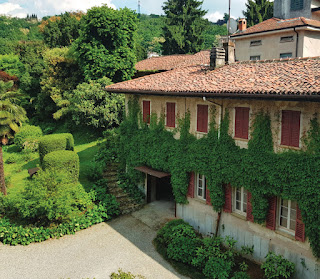
The villa was built by the Pirovano family, which played a significant role not only in local affairs. Today, the original foundation consists of the 17th-century main building. However, the building underwent a radical reorganisation during the 19th century, which adorned the property with eclectic-style decorations and expanded it with the addition of new structures. The most characteristic element, constructed during this phase of renovation, is the neogothic circular tower, initially used as an armory and in the 20th century as a tearoom, greenhouse, and finally as a warehouse.
A mid-19th-century portrait of Villa Manara is provided by Ignazio Cantù with these words, which describe the picturesque eclectic complex: "Magnificence and elegance adorned Villa Pirovano, one of the finest in Brianza, which occupies an enclosure of more than a hundred plots of land, with a casino and Swiss room, a beautifully adorned billiard room, and a superior Chinese room that vividly portrays the fashions of that nation. To this corresponds a rustical apartment in the manner of a Helvetian castle, made more authentic by the battlements of the enclosure. “Here, flowers and fruits destined by nature for other climates, under different skies; here, a lake, here an islet, and monuments of affection, here groves of plane trees and pines, and sources of clear water, and winding avenues, and a small temple, and caves, and rustic huts outside, inside adorned with small chambers, and a round tower with rich armory, and burial monuments, and not far away a fruitful aviary (bird trap ).” In 1833, the villa was purchased by the Manara family, who used it as a summer residence until 1849. These were difficult years of uprisings in resurgent Italy, and in memory of the hero Luciano Manara, who fell in 1849 while defending the Roman Republic, the family had a small temple built in the park that still houses his remains today. The Mannati family succeeded the Manara family through a hereditary line, one of whom had married Virginia, a sister of Luciano Manara.
In the 1930s, the villa was sold, reducing the extent of the park, which originally extended beyond the current provincial road. The lake and laundry areas that were once located beneath Manara's tomb had already disappeared in the 19th century.
